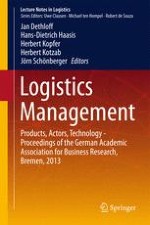2015 | Buch
Logistics Management
Products, Actors, Technology - Proceedings of the German Academic Association for Business Research, Bremen, 2013
herausgegeben von: Jan Dethloff, Hans-Dietrich Haasis, Herbert Kopfer, Herbert Kotzab, Jörn Schönberger
Verlag: Springer International Publishing
Buchreihe : Lecture Notes in Logistics
